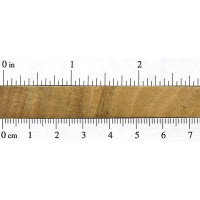 |
Common Name(s): Persimmon, White Ebony Scientific Name: Diospyros virginiana Distribution: Eastern United States Tree Size: 60-80 ft (18-24 m) tall, 1-2 ft (.3-.6 m) trunk diameter Average Dried Weight: 52 lbs/ft3 (835 kg/m3) Specific Gravity (Basic, 12% MC): .74, .83 Janka Hardness: 2,300 lbf (10,230 N) Modulus of Rupture: 17,700 lbf/in2 (122.1 MPa) Elastic Modulus: 2,010,000 lbf/in2 (13.86 GPa) Crushing Strength: 9,170 lbf/in2 (63.2 MPa) Shrinkage: Radial: 7.9%, Tangential: 11.2%, Volumetric: 19.1%, T/R Ratio: 1.4 |
Color/Appearance: Very wide sapwood is a white to pale yellowish-brown. Color tends to darken with age. Very thin heartwood (usually less than 1″ wide) is dark brown to black, similar to ebony. (Persimmon is in the same genus—Diospyros—as true ebonies.)
Grain/Texture: Grain is straight, with a uniform medium-coarse texture.
Endgrain: Semi-ring-porous; medium-large earlywood pores sometimes form broken rows, latewood pores medium-small; solitary and radial multiples of 2-3; growth rings usually distinct; narrow rays not visible without lens, close spacing; parenchyma diffuse-in-aggregates, vasicentric, and banded (reticulate and marginal).
Rot Resistance: Being that nearly all of Persimmon is sapwood, it is rated as perishable and is susceptible to insect attack.
Workability: Overall workability is so-so. Persimmon generally responds well to hand tools, but can be difficult to plane and blunts cutting edges faster than expected. Turns and finishes well.
Odor: No characteristic odor.
Allergies/Toxicity: Persimmon has been reported to cause skin irritation. See the articles Wood Allergies and Toxicity and Wood Dust Safety for more information.
Pricing/Availability: Not commonly available in lumber form, Persimmon may occasionally be seen in smaller blocks or turning blanks. Expect prices to be high for a domestic species.
Sustainability: This wood species is not listed in the CITES Appendices or on the IUCN Red List of Threatened Species.
Common Uses: Turned objects, golf club heads, veneer, and other small specialty wood items.
Comments: Persimmon trees are known much more commonly for their fruit, and not their wood. Persimmon is technically related to true ebonies (Diospyros genus), and is therefore sometimes referred to as “white ebony.”
Persimmon wood is heavy, hard, and strong for a temperate species. It has excellent shock and wear resistance, but has a very high shrinkage rate, and may experience significant movement in service.
Scans/Pictures:









I have a Pisgah open-back banjo made from persimmon. It’s a beautiful instrument, and I love how the inlaid star design on the headstock pops against the lighter wood. But it’s a heavy banjo, and definitely heavier than other open-back Pisgahs. I think the wood plus the goat hide head give the banjo the low, boomy tone that I love about it though.
Have you heard of drying a persimmon log upside down to cause the wood to become black?
I was thinking I was taking a bitternut hickory but turned out to be persimmon. Craft intent. Also concerned with guitar. But electric, not acoustic. Persimmon is HARD, worse than even dogwood. It’s rift if you cut it yourself. Rock maple is one thing, persimmon is much harder. MUCH harder. Ever cut apple? Persimmon is MUCH harder. I have a stock of cherry and apple (and old pear). Get your tools sharp, friend. Persimmon is far harder than those. It will make you earn your keep.
How should I go about proper log curing persimmon? I just lost one to storm damage and have 4 logs 10-20feet each. Tree was big when I bought my house in 1993. It’s at least 30 years of growth. More deep purple colored heartwood than online descriptions suggest.
One source noted to dry the green stuff like it is double the thickness of red oak since it splits easily. Red oak needs dried slowly, outdoors, in the cool shadow, especially slowly for the 8/4 thickness of oak. Seal the ends doublely. Cut it thinner.
I have one log sliced in 5/4. Wish I had found the drying suggestion before cutting so I could have gone 4/4 or 3/4 thickness. Previously drying a woodturning at 0.25 inch thickness, I had no problems. Used multiple layers of brown paper bags filled with shavings.
Good luck.
First,get the bark off to keep the insect borers at bay; then put bees wax or wood glue on the end grain within a couple days, or checking will ruin it-fast.. then keep the sun off. This wood checks, warps fast. Workability? Ummm, yeah you better have sharp tools and then expect a workout! I made a little bandsaw box(about 4″x3″for my g-daughter. The lid was 2.5″ diameter; to sand it smooth I used 4 new sheets of 220 grit sandpaperon a flat surface-rubbing hard and fast. It took half an hour. To do coarse shaping on beltsander,it used a… Read more »
I recently purchased some property with an old log cabin, barn, sheds. The barn and house are circa 1880. To my surprise most of the timbers are Persimmon. Big ones. They are still hard and sturdy but have definite shrinkage.
Persimmon trees are very common here in Oklahoma – we’ve got 12-15 of them on a less than 1 acre neighborhood property. They tend to be small tho, largest is 35″ circumference at breast height.
Where in Oklahoma. I’m in Oklahoma and I’ve never seen one near the southern border of Oklahoma
RC Tonewoods offers sets, fretboards, and bridge blanks from time to time.
Hi there Harold, Though i’m afraid i can’t help you with a specific source, if i were you i’d look into Japanese timber suppliers internationally as persimmon has been used a great deal in high level joinery and cabinet making for centuries. And as a result of relying on old trees, you can usually get timber with massive areas of black heartwood compared to what you could get domestically. It’ll be called ‘kurogaki or kurokaki’ ?? with the highest quality and most desirable boards being highly figured and overall similar to black and white ebony. You can expect prices to… Read more »